Abstract
A total of 339 Yersinia strains were tested for virulence-associated autoagglutination and hemagglutinin (HA) production. Autoagglutination was frequent among human clinical isolates belonging to Y. enterocolitica serogroups O:3, O:8, and O:9 and among porcine isolates of serogroups O:3 and O:9. Positive autoagglutination results were also observed in serogroups O:1 and O:2, associated with outbreaks among chinchillas, hares, and goats. All of 164 environmental isolates were negative in the autoagglutination assay. When subcultured serially in nutrient broth, none of the clinical isolates produced HA at either 22 or 37 degrees C, whereas 22.6% of the environmental yersiniae yielded mannose-resistant HA (MRHA). Six different MRHA patterns were recorded. Eighteen strains, all of which produced MRHA in nutrient broth, yielded similar MRHA patterns after cultivation on colonization factor agar. None of the autoagglutination-positive-(AA+) strains produced MRHA in either nutrient broth or on colonization factor agar. In contrast, a distinct autoagglutination-associated MRHA was detected after growth in Eagle minimal essential medium. Comparison of AA+ and autoagglutination-negative (AA-) derivatives of serogroups O:2, O:3, O:5, O:8, and O:9 showed that all AA+ cultures produced MRHA when grown in minimal essential medium at 37 degrees C overnight, whereas no MRHA was observed with any of the AA- derivatives of the same serogroups. This autoagglutination associated MRHA reacted with guinea pig erythrocytes, but not with erythrocytes from seven other species.
Full text
PDF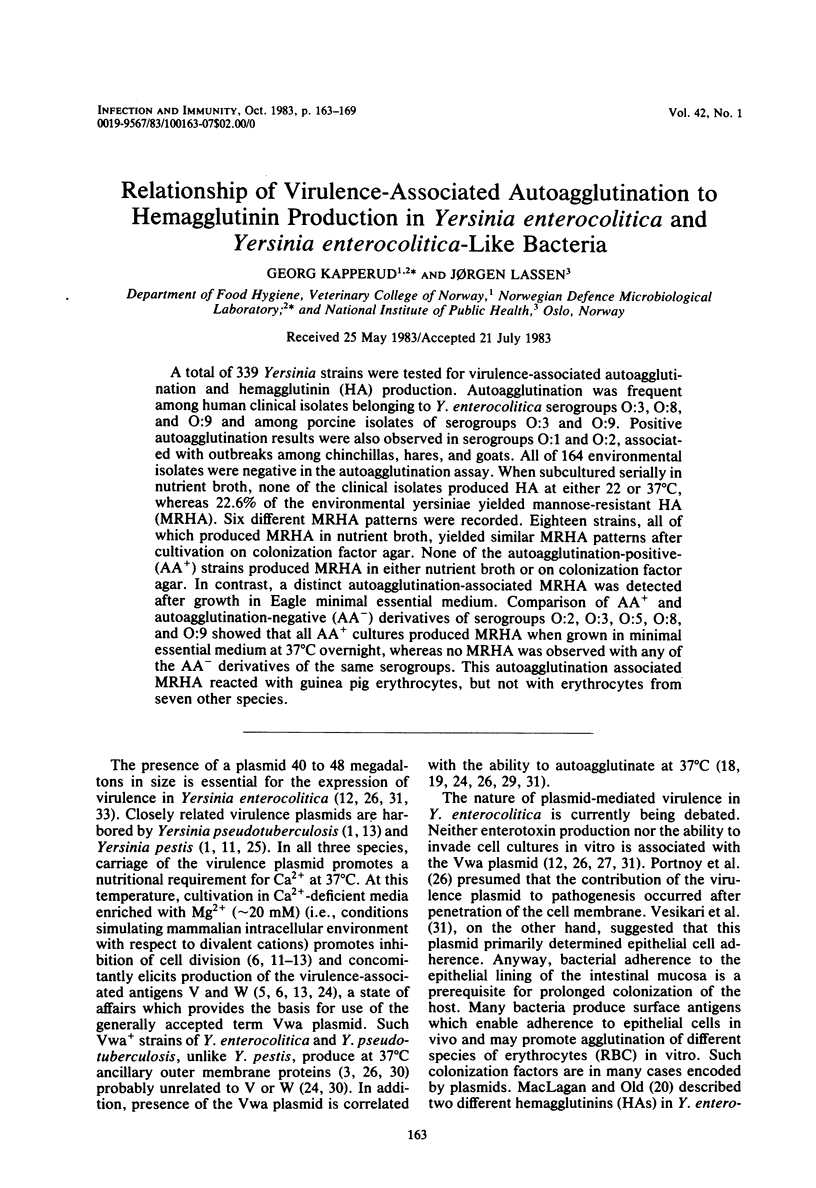
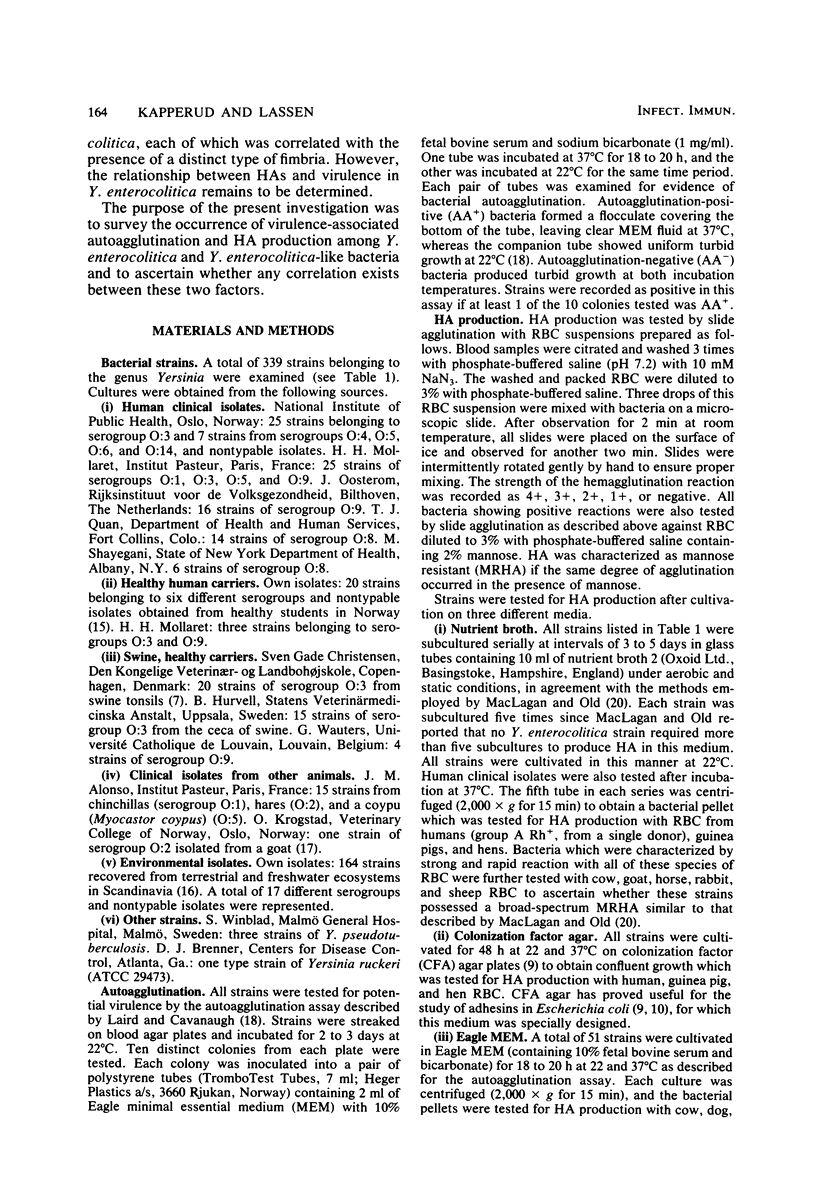
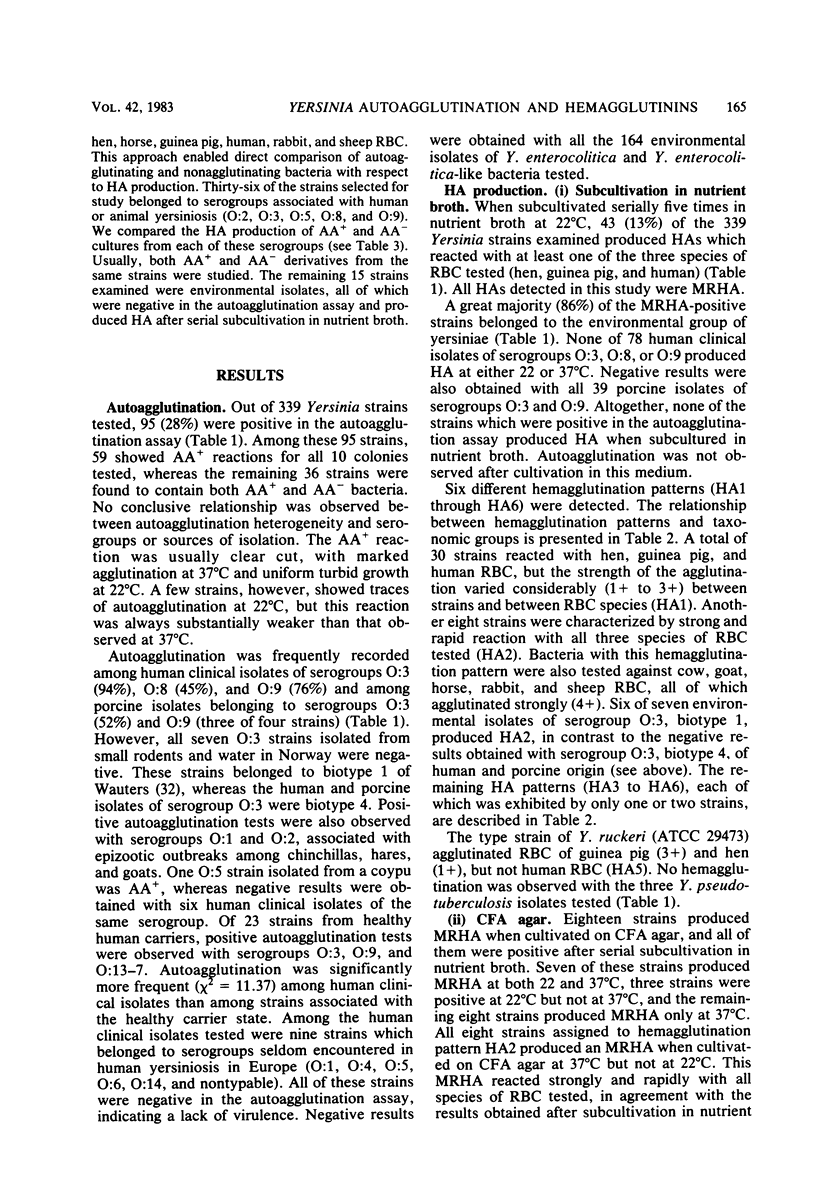
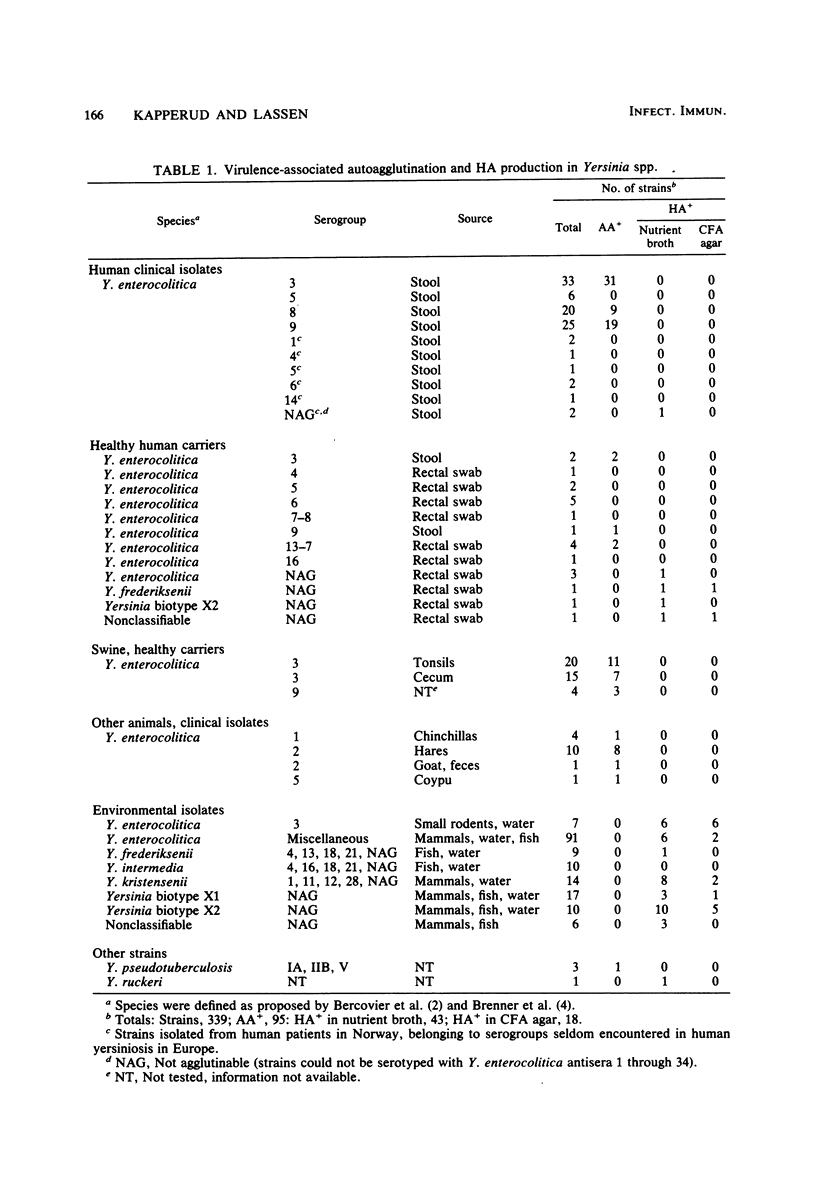
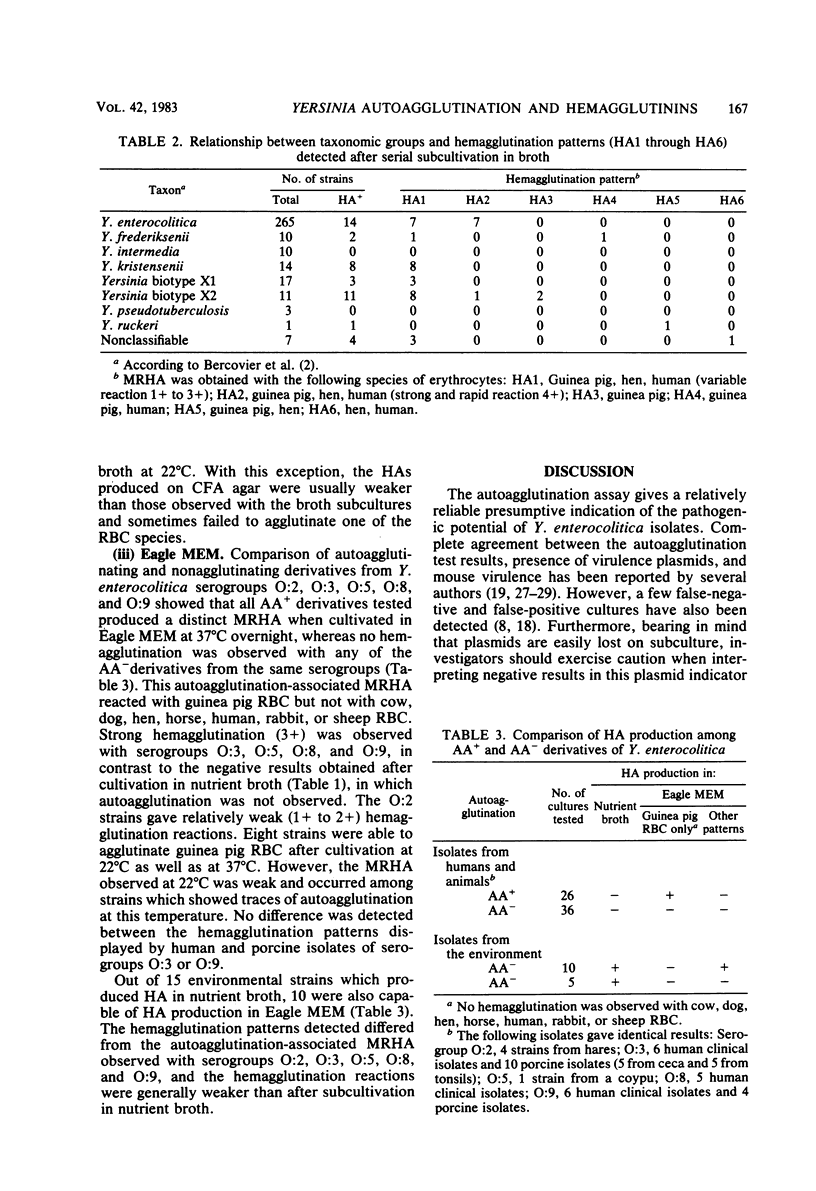
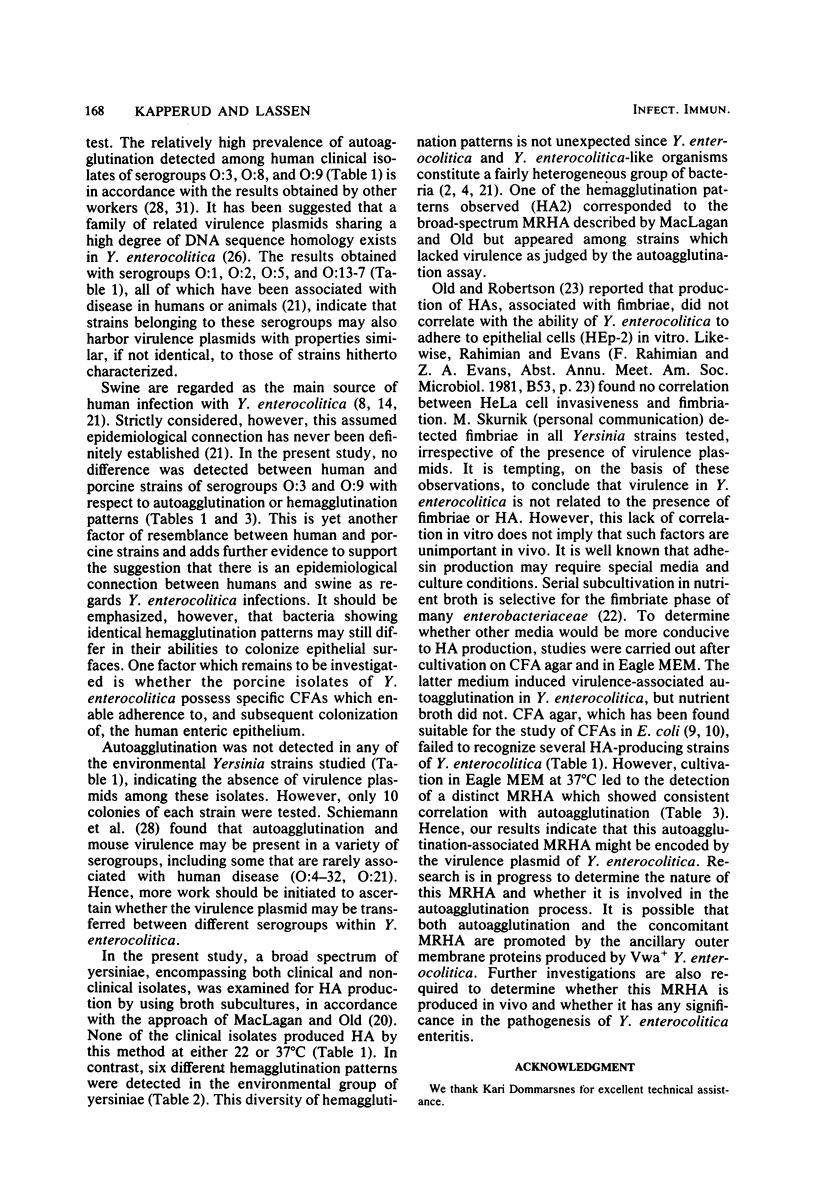
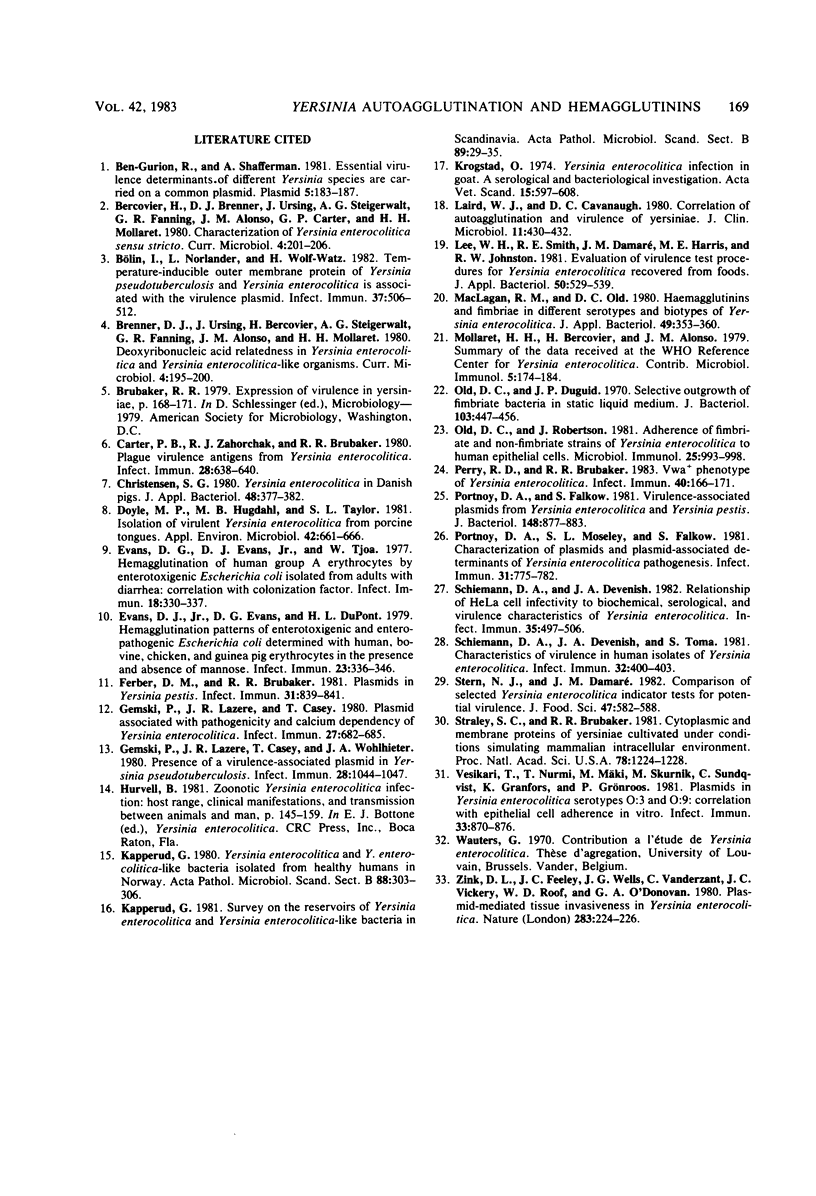
Selected References
These references are in PubMed. This may not be the complete list of references from this article.
- Ben-Gurion R., Shafferman A. Essential virulence determinants of different Yersinia species are carried on a common plasmid. Plasmid. 1981 Mar;5(2):183–187. doi: 10.1016/0147-619x(81)90019-6. [DOI] [PubMed] [Google Scholar]
- Bölin I., Norlander L., Wolf-Watz H. Temperature-inducible outer membrane protein of Yersinia pseudotuberculosis and Yersinia enterocolitica is associated with the virulence plasmid. Infect Immun. 1982 Aug;37(2):506–512. doi: 10.1128/iai.37.2.506-512.1982. [DOI] [PMC free article] [PubMed] [Google Scholar]
- Carter P. B., Zahorchak R. J., Brubaker R. R. Plague virulence antigens from Yersinia enterocolitica. Infect Immun. 1980 May;28(2):638–640. doi: 10.1128/iai.28.2.638-640.1980. [DOI] [PMC free article] [PubMed] [Google Scholar]
- Christensen S. G. Yersinia enterocolitica in Danish pigs. J Appl Bacteriol. 1980 Jun;48(3):377–382. doi: 10.1111/j.1365-2672.1980.tb01025.x. [DOI] [PubMed] [Google Scholar]
- Doyle M. P., Hugdahl M. B., Taylor S. L. Isolation of virulent Yersinia enterocolitica from porcine tongues. Appl Environ Microbiol. 1981 Oct;42(4):661–666. doi: 10.1128/aem.42.4.661-666.1981. [DOI] [PMC free article] [PubMed] [Google Scholar]
- Evans D. G., Evans D. J., Jr, Tjoa W. Hemagglutination of human group A erythrocytes by enterotoxigenic Escherichia coli isolated from adults with diarrhea: correlation with colonization factor. Infect Immun. 1977 Nov;18(2):330–337. doi: 10.1128/iai.18.2.330-337.1977. [DOI] [PMC free article] [PubMed] [Google Scholar]
- Evans D. J., Jr, Evans D. G., DuPont H. L. Hemagglutination patterns of enterotoxigenic and enteropathogenic Escherichia coli determined with human, bovine, chicken, and guinea pig erythrocytes in the presence and absence of mannose. Infect Immun. 1979 Feb;23(2):336–346. doi: 10.1128/iai.23.2.336-346.1979. [DOI] [PMC free article] [PubMed] [Google Scholar]
- Ferber D. M., Brubaker R. R. Plasmids in Yersinia pestis. Infect Immun. 1981 Feb;31(2):839–841. doi: 10.1128/iai.31.2.839-841.1981. [DOI] [PMC free article] [PubMed] [Google Scholar]
- Gemski P., Lazere J. R., Casey T. Plasmid associated with pathogenicity and calcium dependency of Yersinia enterocolitica. Infect Immun. 1980 Feb;27(2):682–685. doi: 10.1128/iai.27.2.682-685.1980. [DOI] [PMC free article] [PubMed] [Google Scholar]
- Gemski P., Lazere J. R., Casey T., Wohlhieter J. A. Presence of a virulence-associated plasmid in Yersinia pseudotuberculosis. Infect Immun. 1980 Jun;28(3):1044–1047. doi: 10.1128/iai.28.3.1044-1047.1980. [DOI] [PMC free article] [PubMed] [Google Scholar]
- Kapperud G. Survey on the reservoirs of Yersinia enterocolitica and Yersinia enterocolitica-like bacteria in Scandinavia. Acta Pathol Microbiol Scand B. 1981 Feb;89(1):29–35. doi: 10.1111/j.1699-0463.1981.tb00148_89b.x. [DOI] [PubMed] [Google Scholar]
- Kapperud G. Yersinia enterocolitica and Y. enterocolitica-like bacteria isolated from healthy humans in Norway. Acta Pathol Microbiol Scand B. 1980 Dec;88(6):303–306. doi: 10.1111/j.1699-0463.1980.tb02646.x. [DOI] [PubMed] [Google Scholar]
- Krogstad O. Yersinia enterocolitica infection in goat. A serological and bacteriological investigation. Acta Vet Scand. 1974;15(4):597–608. doi: 10.1186/BF03547229. [DOI] [PMC free article] [PubMed] [Google Scholar]
- Laird W. J., Cavanaugh D. C. Correlation of autoagglutination and virulence of yersiniae. J Clin Microbiol. 1980 Apr;11(4):430–432. doi: 10.1128/jcm.11.4.430-432.1980. [DOI] [PMC free article] [PubMed] [Google Scholar]
- Lee W. H., Smith R. E., Damaré J. M., Harris M. E., Johnston R. W. Evaluation of virulence test procedures for Yersinia enterocolitica recovered from foods. J Appl Bacteriol. 1981 Jun;50(3):529–539. doi: 10.1111/j.1365-2672.1981.tb04255.x. [DOI] [PubMed] [Google Scholar]
- Maclagan R. M., Old D. C. Haemagglutinins and fimbriae in different serotypes and biotypes of Yersinia enterocolitica. J Appl Bacteriol. 1980 Oct;49(2):353–360. doi: 10.1111/j.1365-2672.1980.tb05135.x. [DOI] [PubMed] [Google Scholar]
- Mollaret H. H., Bercovier H., Alonso J. M. Summary of the data received at the WHO Reference Center for Yersinia enterocolitica. Contrib Microbiol Immunol. 1979;5:174–184. [PubMed] [Google Scholar]
- Old D. C., Duguid J. P. Selective outgrowth of fimbriate bacteria in static liquid medium. J Bacteriol. 1970 Aug;103(2):447–456. doi: 10.1128/jb.103.2.447-456.1970. [DOI] [PMC free article] [PubMed] [Google Scholar]
- Old D. C., Robertson J. Adherence of fimbriate and non-fimbriate strains of Yersinia enterocolitica to human epithelial cells. Microbiol Immunol. 1981;25(10):993–998. doi: 10.1111/j.1348-0421.1981.tb00105.x. [DOI] [PubMed] [Google Scholar]
- Perry R. D., Brubaker R. R. Vwa+ phenotype of Yersinia enterocolitica. Infect Immun. 1983 Apr;40(1):166–171. doi: 10.1128/iai.40.1.166-171.1983. [DOI] [PMC free article] [PubMed] [Google Scholar]
- Portnoy D. A., Falkow S. Virulence-associated plasmids from Yersinia enterocolitica and Yersinia pestis. J Bacteriol. 1981 Dec;148(3):877–883. doi: 10.1128/jb.148.3.877-883.1981. [DOI] [PMC free article] [PubMed] [Google Scholar]
- Portnoy D. A., Moseley S. L., Falkow S. Characterization of plasmids and plasmid-associated determinants of Yersinia enterocolitica pathogenesis. Infect Immun. 1981 Feb;31(2):775–782. doi: 10.1128/iai.31.2.775-782.1981. [DOI] [PMC free article] [PubMed] [Google Scholar]
- Schiemann D. A., Devenish J. A. Relationship of HeLa cell infectivity to biochemical, serological, and virulence characteristics of Yersinia enterocolitica. Infect Immun. 1982 Feb;35(2):497–506. doi: 10.1128/iai.35.2.497-506.1982. [DOI] [PMC free article] [PubMed] [Google Scholar]
- Schiemann D. A., Devenish J. A., Toma S. Characteristics of virulence in human isolates of Yersinia enterocolitica. Infect Immun. 1981 Apr;32(1):400–403. doi: 10.1128/iai.32.1.400-403.1981. [DOI] [PMC free article] [PubMed] [Google Scholar]
- Straley S. C., Brubaker R. R. Cytoplasmic and membrane proteins of yersiniae cultivated under conditions simulating mammalian intracellular environment. Proc Natl Acad Sci U S A. 1981 Feb;78(2):1224–1228. doi: 10.1073/pnas.78.2.1224. [DOI] [PMC free article] [PubMed] [Google Scholar]
- Vesikari T., Nurmi T., Mäki M., Skurnik M., Sundqvist C., Granfors K., Grönroos P. Plasmids in Yersinia enterocolitica serotypes O:3 and O:9: correlation with epithelial cell adherence in vitro. Infect Immun. 1981 Sep;33(3):870–876. doi: 10.1128/iai.33.3.870-876.1981. [DOI] [PMC free article] [PubMed] [Google Scholar]
- Zink D. L., Feeley J. C., Wells J. G., Vanderzant C., Vickery J. C., Roof W. D., O'Donovan G. A. Plasmid-mediated tissue invasiveness in Yersinia enterocolitica. Nature. 1980 Jan 10;283(5743):224–226. doi: 10.1038/283224a0. [DOI] [PubMed] [Google Scholar]


